Karkala
Karkala [kaːrkəɭɐ] also known as Karla, is a town and the headquarters of Karkala taluk in the Udupi district of Karnataka, India. Located about 60 km from Mangalore, it lies near the Western Ghats.
Karkala Karla | |
|---|---|
Town | |
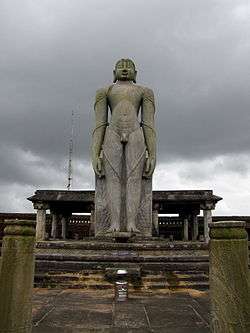 Gommateshwara statue at Karkala | |
| Nickname(s): Jain pilgrimage center | |
 Karkala Location in Karnataka, India | |
| Coordinates: 13.2°N 74.983°E | |
| Country | |
| State | Karnataka |
| Region | Tulu Nadu |
| Settled | 1912 |
| Headquarters | Udupi |
| Area | |
| • Total | 23.06 km2 (8.90 sq mi) |
| Elevation | 80 m (260 ft) |
| Population (2011) | |
| • Total | 25,824 |
| • Density | 1,089.16/km2 (2,820.9/sq mi) |
| Languages | |
| • Official | Kannada |
| • Regional | Tulu, Konkani |
| Time zone | UTC+5:30 (IST) |
| PIN | 574 104 |
| Telephone code | 91-(0)8258 |
| Vehicle registration | KA-20 |
| Sex ratio | 1.11 ♂/♀ |
| Website | www |
| The Famous Jain Centre | |
The town was called Pandya Nagari (ಪಾಂಡ್ಯ ನಗರಿ) during the period of Jain rule, and later became known as Karikallu (ಕರಿಕಲ್ಲು), then Karkal (ಕಾರ್ಕಲ್) and then finally to Karkala (ಕಾರ್ಕಳ).
Karkala has a number of natural and historical landmarks. It is located at the bottom of Western Ghats covered with greenery year-round. It is a major junction for religious tourists due to its strategic location along the way to Hebri, Sringeri, Kalasa, Horanadu, Udupi, Kollur, Subrahmanya and Dharmasthala.
Nallur is a village situated in the Karkala taluk. Here, Athishaya Nallur jain temple were built long ages Ago.
History and origin
Karkala dates back to the beginning of the 10th century.
Etymology
Black granite is abundant in the area, and is in wide use in the local architecture. The name of the town is derived from kari-kal, meaning black stone in Kannada. Some assert that the original name was 'Kari Kola' meaning 'elephant lake' in Kannada which is the existing 'Anekere'. Tulu-speaking people call the town Karla, Kannadigas call it Karkala, and the Roman Catholics call it Karkol. Its alternative name, Jain Tirtha, is the result of 300 years of Jain rule. It was called Karkal by the English; later, it was called Karkala in Kannada. Karkala is on the top of a granite bed that is about 300–500 ft thick.
Ancient legends
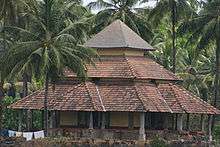
The Alupas were the first to rule Karkala. Their rule was followed by the Santaras, who were the feudatories of Alupas for many years. Karkala, or ancient Pandya Nagari, attained political and cultural importance from the time of the Kalasa-Karkala kingdom that was established by King Bhairava between 13th and 16th centuries. They appear to be the descendants of the Santara chiefs, who ruled the Western Ghats region around the 11th century AD.
The royal family of Karkala rose to prominence right from the time of the Hoysalas. During the Vijayanagara period this family reached new heights of glory. Their kingdom extended over a wider area comprising Sringeri, Koppa, Balehonnur and Mudigere in Chikamagalur and most of the Karkala taluk. They were rich and maintained a large army. Despite engaging in wars, peace prevailed in the kingdom and this led to increased cultural activity and development.
The first important King was Veera Bhairava, who constructed basadis at Karkala and endowed land and money to numerous temples and basadis. Ramanatha and Veerapandya were his two sons. Ramanatha died during his father's time. In his memory, a scenic lake called Ramasamudra was created, which still survives.
King Veera Pandya, at the insistence of his Guru Lalitakeerti, the pontiff of Karkala Jaina Math, installed a large statue of Bahubali on the rocky hill of Karkala. The date of the installation has been ascertained as 13 February 1432. Veera Pandya also installed the Brahmadeva Pillar in front of the statue in 1436.
Abinava Pandya ascended the throne next and it was he who installed a carving of manastambha in front of the Neminatha Basadis in Hiriyangadi in 1457 AD. An intricately carved 54-foot-high (16 m) pillar stands in front of the Basadis. The Neminatha Basadis was renovated in 1946. An oriental school with free boarding and lodging facilities is being run here by the Bhujabali Brahmacharya Ashrama.
Abhinava Pandya's successor was Pandya VI. He built the Kere Basadis in the middle of a lake called Anekere in 1545 AD. It is in this lake that the king's elephants used to bath. The Basadis and the lake still exist.
The next important king was Immadi Bhairava (Bhairava II). He constructed the Chaturmukha Basadi on top of a small rocky hill in 1586 AD. The Basadis has four identical entrances from the four quarters leading to the Garbagriha and hence is popularly known as Chaturmukha Basadis. It is referred to as Tribhuvana Tilaka Jina Chaityalaya and Ratnaraya Dhama in some inscriptions. The Chaturmukha Basadi is built in the form of a square mandapa or hall with a lofty doorway and pillared portico on each of its four sides and a pillared verandah. The roof is flat and is made of massive granite slabs. It has life size statues of three theerthankaras on each side and small images of 24 Tirthankara. It took 30 years to construct this temple. In all, there are 108 pillars inside and outside the temple.
This place also came under the rule of Tippu Sultan. It was under him that some of the untold and disappearing landmarks of Karkala (ಕಾರ್ಕಲ್) were made. One of the most imminent of the time was the Kotay kani moat made in front of the Karkal Kotay castle, which was used during his war against the East India Company. In this war against East India Company, few of Indian Kingdom of Mysore's elite soldiers with huge contribution and service towards the land and kingdom were granted Title and Land in the township of Karkalla. One such title is Karkala Patayath(K.P). Second such marvel of the same regime is to discover the usage of a Gavi (or cave) route to travel to various surrounding location unseen through the mountains located near Shivati Kere (Lord Shivas lake).
There are 18 Basadis of antiquity, including Mahaveera Basadi, Chandranathaswamy Basadi, Adinathaswamy Basadi, Ananthanatha Basadi, Guru BasadiBasadi, and Padmavati Basadi. However, the rulers of Karkala were tolerant towards other religions. Therefore, temples of other religions exist, including the temples of Anantashayana and Venkataramana, Mahamaya Mukhyaprana, and Sri Aadi-Shakthi Veerabhadra Swamy. The St Lawrence Church was built in 1845 in a village called Nitte (Attur hamlet) where people of all religions congregate every year in January for the feast of St Lawrence.
History
The Alupas were the first to rule Karkala. Their rule was followed by the Santaras, who were the feudatories of Alupas for many years. Karkala, or ancient Pandya Nagari, attained political and cultural importance from the time of the Kalasa-Karkala kingdom that was established by Bhairavarasa Odeyas between 13th and 16th centuries. The Bhairavarasas appear to be the descendants of the Santara chiefs, who ruled the western ghats region around the 11th century AD.
The royal family of Karkala rose to prominence during the time of the Hoysalas. During the Vijayanagara period, they expanded their kingdom to cover Sringeri, Koppa, Balehonnur, and Mudigere in Chikamagalur and most of the Karkala taluk.
The king Veera Bhairava[1] constructed Basadis at Karkala and endowed land and money on numerous temples and Basadis. Ramanatha and Veerapandya were his two sons. Ramanatha predeceased his father, and in his memory, a lake called Ramasamudra was created, which still survives. Later, King Veera Pandya installed a large statue of Bahubali on the rocky hill of Karkala. The date of the installation has been ascertained as 13 February 1432. Veera Pandya also installed the Brahmadeva Pillar in front of the statue in 1436. His successor, Abinava Pandya, installed an intricate 54-foot-high (16 m) carving of manastambha in front of the Neminatha Basadi in Hiriyangadi in 1457 AD. Later, Pandya VI built the Kere Basadi in the middle of a lake called Anekere in 1545 AD.[2]
There are 18 Basadis of antiquity, including Mahaveera Basadi, Chandranathaswamy Basadi, Adinathaswamy Basadi, Ananthanatha Basadi, Guru Basadi, and Padmavathi Basadi. However, the rulers of Karkala were tolerant towards other religions. Therefore, temples of other religions exist, including the temples of Anantashayana and Venkataramana, Mahamaya Mukhyaprana, and Sri Aadi Shakthi Veerabhadra Swamy. The St Lawrence Church was built in 1845 in a village called Nitte (Attur hamlet) where people of all religions congregate every year in January for the feast of St Lawrence.[3]
Religion
Jainism is widely practised in Karkala, and is a pilgrimage destination for Jains due to its historical importance in the Jain religion. The single stone 41.5 feet (13 m) statue Gommateshwara (Lord Bahubali) is located about 1 km from the center of the town and is the second tallest in Karnataka. There are about 18 Jain Basadis in Karkala, including the Chaturmukha Basadi, Hiriyangaddi Neminatha Basadi, and Anekere Padmavathi Basadi, all of which are listed in Archaeological Survey of India. This statue of Lord Bahubali was installed at Karkala on 13 February 1432 on the instructions of the pontiff of Karkala, Lalitakeerti. There are several other temples, mosques, and churches in and around Karkala. St. Lawrence minor basilica is situated on the outskirts of Karkala whereas Christ king church in the town.
There are good number of Gouda Saraswath Brahmins who are settled in this area and have been contributing a large way to the local economy in terms of trade, agriculture and industries. The Karkala Venkataramana Temple, led by the same community is known as 'padutirupati' (west tirupati), which is a holy place to visit.
The other statues of Bahubali in the state are at Shravanabelagola installed by Chavundaraya, which is 57 feet tall, at Venur installed by Timmaraja, which is 35 feet (11 m) tall, and at Dharmasthala installed by Dr. Veerendra Heggade, which is 39 feet (12 m) tall.
Mahamastakabhisheka
Every twelve years, hundreds of thousands of Jain devotees congregate to perform the Mahamastakabhisheka, a ceremony where the Gommateshwara statue is bathed and anointed with milk, water, and saffron paste and sprinkled with sandalwood powder, turmeric, and vermilion. The last Mahamastakabhisheka was held in January 2015. An annual Rathotsava is held in February.
Mahamasthakabhisheka of Lord Bahubali
The Mahamastakabhisheka of Lord Bahubali at Karkala was held during 21–31 January 2015 under the auspices of the Sri Bahubali Swamy Mahamasthakabhisheka Samithi. The towering 41.5 ft. granite monolith of Bahubali - also known as Gommateshwara - is built on an elevated platform on top of a rocky hill, known locally as Gommata Betta. Gommateshwara is also known as Gommata and Gomateshwara. The colossus was consecrated on 13 February 1432 A.D. by Veera Pandya Bhairarasa Wodeyar, scion of the Bhairarasa Dynasty, feudatory of the Vijayanagara Rulers.
The Mahamastakabhisheka (ceremonial anointment) of the statue is done once every 12 years, a Jain religious rite that dates back to ancient times. The ceremonial anointing will be done customarily from the top of a specially constructed scaffolding, when water from 1008 kalashas (pots) will be poured over the Gommata, as a purification rite. The abhisheka (ceremonial bathing) then begins to the heralding of bugles and the beat of drums. Milk from kalashas and large containers is poured on Gommateshwara, followed by clouds of white rice powder. Next, the statue is anointed with coconut water and sugarcane juice. Liquid turmeric and red sandalwood paste then cover the Gommata in hues of amber and mahogany. Next comes the libation of ashtagandha - a combination of eight scented substances - followed lastly by a shower of flower petals. The splendid ceremony ends with the washing of the Gommata with the clear waters of the poorna kumbhas and the arathi of lit lamps. This unique event draws thousands of pilgrims from all over the country as well as across the world, who are enriched by the cultural experience.
Jainism was introduced in Karnataka by Lord Mahaveera in the 6th Century B.C during the course of his travels, when he converted Jivandhara, the king of the Hemangada Country into Jainism. Foretelling a major famine, Monk Bhadrabahu, a leading figure of the Jain religion in the kingdom of Magadha in the 3rd century B.C, led a major migration to Karnataka with Emperor Chandra Gupta Maurya and attained samadhi in the area now known as Shravanabelagola. By the 10th Century, Jainism had become a powerful force in the coastal regions of Karnataka and centres were established all along. With the ascendance of Hinduism, the influence of Jainism waned in the country, though Karnataka still has active Jain pilgrimage centres.
Mahamastakabhisheka, held once every 12 years and Attur Fest, held once a year are some festivals of Karkala which attract major crowd from all over the country.
Landmarks
Karkala is a pilgrimage location for Jains and it attracts tourists. There are several Hindu temples, Jain Basadis, mosques, churches, and lakes in Karkala.
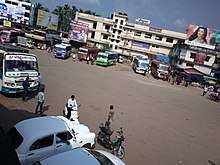
Karkala has famous educational institutions like NITTE College, Shri Bhuvenendra College, Christ king Educational institutions, Jnanasuda Educational College.
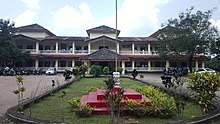
Archaeological Survey Of India protected sites
The following historical structures are the great examples of art and architecture. They are protected by various laws of the Government of India. ASI protected sites[4] in Karkala are
- Ananthapadmanabha Temple, Ananthashayana
- Chaturmukha Basadi
- Gommateshwara Statue
- Manasthamba, Hiriyangadi, Karkala
Padutirupathi Karkala
Padutirupathi is a temple dating back to the 14th century when the Jain Bhairarasa Odeyars ruled Karkala and the surrounding area. It still serves as a gathering place for the people of Karkala today.[5]
St. Lawrence Shrine
St. Lawrence Shrine, or Attur church, was built in the 18th century by Christians who fled Tippu Sultan rule in India. It is a Catholic church dedicated to St. Lawrence, and serves the Christian population of India. The church feast which is commonly known as "Karkala Attur Feast" is very famous in the district of Udupi and Dakshina Kannada. It's a 5-day festival in which thousands of people from various cities and districts participate.
Geography
Karkala is located at 13.2°N 74.98°E.[6] It has an average elevation of 81 metres (265 feet).
Meteorological Details
| City area | 23.06 km2. |
| Number of properties | 9526 habitats |
| Length of roads | 77.5 km |
| Total water supply | 2 MLD |
| Type of land | Wet |
| Water supply source | Mundli River, Maala River |
| Summer temperature | 38 °C |
| Winter temperature | 24 °C |
| Annual rainfall | 4372.7mm |
| Agriculture crops | Paddy, coconut, arecanut, jackfruit |
| Latitude | 13.2000 |
| Longitude | 74.9833 |
| Altitude (feet) | 265 |
| Lat (DMS) | 13°11'60 N |
| Long (DMS) | 74°58'60 E |
| Altitude (meters) | 80 |
Lakes
Karkala has large number of picturesque lakes. Some of them are
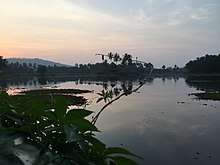
- Ramasamudra Lake
- Kamala Kere
- NagarBavi
- Anekere
- Sigadi Kere
- Matadha Kere
- Shivathi Kere
- Jogina Kere
Demographics
As of 2001 India census,[7] Karkala town had a population of 25,118. Males constitute 51% of the population and females 49%. Karkala has an average literacy rate of 82%, higher than the national average of 59.5%: male literacy is 85%, and female literacy is 79%. In Karkala, 9% of the population is under six years of age. According to recent statistics by town municipality, 25,635 people currently reside in this town, while as per the recent statistics Karkala taluk has a population of 2.10 Lacs (previous 2001 census is 2,04,571).
Hinduism is the largest religion in Karkala, with Rama kshathriya, Bunts, Sapaliga/Sapalya, Billavas, Ganigas, Goud Saraswat Brahmins (GSBs), Chitpavan Brahmins,Shivalli Brahmins, Vishwakarma Brahmins, Devadiga and Mogaveera are the major communities in Hindus. [8]
Culture
The people follow Tuluva culture. Distinctive features of tuluvas include rituals of Bhuta Kola, Nagaradhane and Yakshagana etc. Tuluva New Year is called Bisu, which falls on the same day as Baisakhi, Vishu and Thai New Year.
Language and people
Karkala is a multicultural and multilingual town that follows four religions, namely Hinduism, Islam, Christianity and Jainism. Tulu, Konkani, Kannada, Urdu, Beary are the most prevalent local languages, though Hindi and English are also well understood. There are also Konkani-speaking GSB communities, Urdu and Beary speaking Muslims. The Catholic speak Konkani and Protestant Christians Kannada.
Tradition
Pilinalike (Tiger dance) is a unique form of folk dance in Dakshina Kannada. It is considered as the favored carrier of Goddess Sharada (the deity in whose honour Dasara is celebrated), and is performed during the Dasara celebrations. It is also performed during other festivals like Krishna Janmasthami. Bhuta Kola or spirit worship is practised, usually at night. Kambala, or buffalo racing, is also conducted in paddy fields. Korikatta (Cockfighting) is another favourite sport for village people. To its supporters, Cockfight, an ancient sport involving a fight between specially reared fowls held at the temples precincts in northern parts of Kasaragod, is not a blood sport but a feature of the rich cultural heritage of Tulunadu and an ancient ritual associated with the ‘daivasthanams’ (temples) here.[9] Nagaradhane, or snake worship, is also practised, according to the popular belief that the Naga Devatha (snake God) go underground and guard the species above. Konkani speaking GSBs have their own tradition of celebrating Rathotsava and Deepotsava like the Kannada speaking Brahmins.
Annual Car Festival at Karkala Venkatarama temple attracts Konkani devotees from around the world as this is considered as an auspicious festival amongst the GSB community.
The Christians in Karkala celebrate a special feast known by various names, some of these names are Saanth Maari, Attur Parish Feast, ಅತ್ತೂರು ಜಾತ್ರೆ (Atturu Jatray) and Attur Church festival. This festival is always scheduled to take place in the last week of the month of January and takes place for three days continuously usually Tuesday, Wednesday and Thursday. Thousands of people from all over India attend.
The Muslims offer prayers five times a day at the Masjids and eid prayers at salmar Eidgah on Eid ul fitr and Eid ul adha occasions and Jains have their Jain Milans yearly.
Administration
The Karkala Town Municipal Council (ಕಾರ್ಕಳ ಪುರಸಭೆ) is the Municipal Corporation. Also, Karkala comes under Udupi-Chikkamaglur Lok Sabha Constituency.
Transportation
State and national highways are the main mode of transportation in Karkala. The closest airports and railroads are in Bajpe in Mangalore and Indrali in Udupi,
Roads connected
Karkala is connected to 3 major state roads and one major highway:
- National Highway NH 169 (Solapur-Karkala-Mangalore via Shimoga)
- This will be a 4-lane, 60-meter wide, grade separated highway till Mangalore from Karkala.
- State Highway SH 1 (Karkala-Nitte-Padubidri) which is also connected to National Highway 66 at Padubidri
- State Highway SH 37 (Karkala-Bailur-Manipal-Udupi)
- State Highway SH 1 (Karkala-Hebri)
- National Highway declared on 28 March 2016 - ( Karkala-Moodabidri-Siddakatte-B.C Road) at a cost of Rs.220 Crore.
Railway lines (Proposed)
4 Railway lines have been proposed to be built, which will pass through Karkala. They are
- Byndoor – Kolluru – Haalady – Hebri – Karkala – Moodabidri – Venoor – Belthangady – Dharmasthala - Nettane - Source: -(South-Western Railway approved, but forest department blocked line)
- Padubidri – Karkala – Belthangady – Ujire – Dharmasthala – Nettane - Source:- (South-Western Railway approved, but forest department blocked line)
- Padubidri-Karkala-Ujire-Moodigere - Source:-(Udupi-Chikmagalur Loksabha BJP manifesto).
- Shimoga-Sringeri-Karkala-Mangalore - Source:-(2014-15 Railway Budget).
Commerce
A large steel plant is located in the outskirts of the town named Lamina Foundries ltd. In this semi-urban township Industries are limited to cashew, rice, and coconut-oil only. There is one dynamite factory at Varanga village.
Photo gallery
 Ananthapadmanabha Temple, Karkala
Ananthapadmanabha Temple, Karkala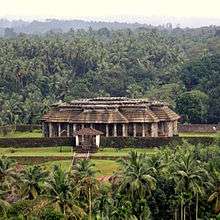 Chaturmukha Basadi, Karkala
Chaturmukha Basadi, Karkala Kere Basadi, Karkala
Kere Basadi, Karkala Padmavati Basadi
Padmavati Basadi- Pillar at Gommateshwara Statue
 Gommateshwara Bahubali Statue
Gommateshwara Bahubali Statue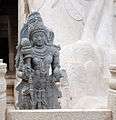 Yaksha on right of Gommateshwara Statue
Yaksha on right of Gommateshwara Statue- The Shilpa at Chaturmukha Basati
- A Pillar at Chaturmukha Basadi
- A Jain temple at the center of pond in Karkala
- Anantha Padmanabha Temple
- Veeramaruthi Temple, Karkala
- St lawrence Church, Karkala
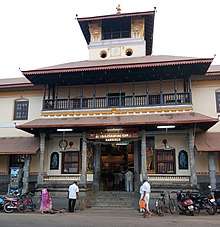 Venkataramana Temple, Karkala
Venkataramana Temple, Karkala- The Deepadhaari at Venkataramana Temple, Karkala
See also
- Moodabidri
- Kere Basadi
- Mangalore
- Shravanabelagola
- Kukke Subramanya Temple
- Dharmasthala
- Siddakatte
- Horanadu
- Sringeri
- Udupi Krishna Temple
- Perdoor
- Mundkur
- Kanthavara
- Jain Bunt
References
- "Western Ghats: News".
- Dynasty, Bairarasas of Karkala. "Birth of the Bravehearts – Koti and Chennaya under Tulunadu King Budyanta". Bellevision. Retrieved 3 August 2018.
- About, Karkala. "Karkala History". srajahiyer.wordpress.com. Retrieved 20 July 2018.
- ASI Bengaluru Circle - Udupi district
- http://www.padutirupathi.org Karkala Sri Venkataramana Temple
- Falling Rain Genomics, Inc - Karkal
- "Census of India 2001: Data from the 2001 Census, including cities, villages and towns (Provisional)". Census Commission of India. Archived from the original on 16 June 2004. Retrieved 1 November 2008.
- South Kanara District Gazetteer 1973, p. 93
- "The Hindu". thehindu.co.in. 10 January 2008.
External links
| Wikimedia Commons has media related to Karkala. |
- Mahamastakabhisheka
- All about The Mahamastakabhisheka of Lord Bahubali at Karkala, 21-31 January 2015
- All about Photographs of Gomateshwara\Bahubali from Karkala
- All about Videos of Gomateshwara\Bahubali from Karkala
- All about Karkala
- Photos from Karkala
- Info about Padutirupathi
- News Topic about Karkala
- St. Lawrence Church, Attur, Karkala
- Shree Venkataramana Temple (Kannada Website)
- Shree Venkataramana Temple (English Website)